Item 1: Report to Shareholders
 |
| Global Technology Fund | December 31, 2006 |
The views and opinions in this report were current as of December 31, 2006. They are not guarantees of performance or investment results and should not be taken as investment advice. Investment decisions reflect a variety of factors, and the managers reserve the right to change their views about individual stocks, sectors, and the markets at any time. As a result, the views expressed should not be relied upon as a forecast of the fund’s future investment intent. The report is certified under the Sarbanes-Oxley Act, which requires mutual funds and other public companies to affirm that, to the best of their knowledge, the information in their financial reports is fairly and accurately stated in all material respects.
REPORTS ON THE WEB
Sign up for our E-mail Program, and you can begin to receive updated fund reports and prospectuses online rather than through the mail. Log in to your account at troweprice.com for more information.
Fellow Shareholders
Global technology stocks rallied in the second half of 2006 to produce solid gains after a weak first half. Equity markets, particularly the emerging markets of China and India, were strong across the globe. Developed market stocks in Europe and the United States posted solid returns for the full year, with much of the gains coming in the second half. The seasonal pattern of technology stocks appreciating in the second half of the year played out for the seventh year of the last eight. Unfortunately for global technology investors, the pattern of technology stocks underperforming the general stock market also continued. Technology stocks have trailed the broad market indices in five of the last six years.

Our fund finished the year with a gain of 10%, beating the Lipper Science & Technology Funds Index and the MSCI AC World Index–Information Technology, which tracks technology stocks in various international markets. For the second half of 2006, the fund outperformed the Lipper index, but our underweight positions in strong-performing IBM and Hewlett Packard caused the fund to lag the MSCI AC World Index, as shown in the accompanying table. The fund’s long-term performance is favorable, as recognized by an Overall Morningstar RatingTM of five stars.
HIGHLIGHTS
• Major U.S. and international equity markets approached or set new records. Global technology stocks rallied in the second half of the year, but they underperformed the overall market.
• The fund registered a solid gain, outperforming its Lipper peer group for the year.
• The release of much-delayed, yet much-anticipated, new generation software programs and gaming systems should help technology stocks this year, and we have positioned the fund to take advantage of these new product cycles.
• We believe that the healthy global economy will provide strong support for the product and secular technology trends that are under way.
(The Global Technology Fund received an Overall Morningstar RatingTM of five stars for its risk-adjusted performance. The fund was rated among 288 and 259 specialty-technology funds for the three- and five-year periods ended December 31, 2006. This rating is derived from a weighted average of the performance figures associated with the fund’s 3-, 5-, and 10-year (if applicable) Morningstar RatingTM metrics. For important information about Morningstar ratings, please refer to page 7.)
MARKET ENVIRONMENT
A healthy global economy helped push equity prices higher in 2006. Although geopolitical issues continued to dampen investor sentiment, large amounts of liquidity, a decline in commodity prices, and benign inflation encouraged investors to take on more risk in their portfolios. The five-year U.S. economic expansion appears to have slowed a bit in 2006 following a long series of Federal Reserve interest rate hikes, but the developed economies in Europe and Japan are healthier than they have been in the recent past. Emerging market economies continue to demonstrate remarkable health, highlighted by booming growth in the world’s most populous countries, China and India. Taiwan and South Korea, home to numerous technology companies, experienced internal political turmoil that constrained their normally vibrant domestic economies.
As we head into 2007, global interest rates remain near historical lows. The Federal Reserve paused its two-year campaign of rising interest rates last June, and investors hope that its next move will be to lower rates. In contrast, the European Central Bank and the Bank of Japan raised rates in the second half of 2006 and are expected to hike them again this year.
Global technology stocks rebounded along with the general market in the second half of 2006. Underscoring the short-term orientation of many investors, technology stocks responded positively to data indicating that holiday sales of consumer technology products were strong and would absorb some of the bloated inventory levels that had held back technology sales and earnings earlier in the year. Investors also gained confidence that some of the delayed technology products were on target for delivery in late 2006 or early 2007. For example, Microsoft released Vista, its much-heralded and much-delayed new operating system, to corporate users in the fourth quarter and scheduled the release of the consumer version in the first quarter of 2007. Sony and Nintendo brought to market their new video gaming platforms whose release had been pushed back from earlier in the year. Yahoo! appears poised to release its delayed new advertising platform early this year. While postponing the release of these products hurt the tech stock performance in 2006, the introduction of these products should have a positive influence in 2007, in our view. (Please refer to the fund’s portfolio of investments for a complete listing of our holdings and the amount each represents in the portfolio.)
PORTFOLIO REVIEW
The fund’s top contributors in 2006 were Internet holdings Tencent and Digital River, telecommunications equipment provider Cisco Systems, information technology services provider Infosys, and video game designer Ubisoft. We believe that owning companies that provide services and products over the Internet represents great growth opportunities, and the fund has significant positions in Internet-related companies with multiyear growth horizons, such as Tencent and Digital River. Tencent is China’s largest Internet company; it has a dominant share of the instant messaging market, and it is a leading domestic provider of online content and commerce opportunities. Digital River (U.S.) is the top provider of e-commerce services that enable companies to operate Web-based businesses. Cisco (U.S.), the large maker of Internet networking infrastructure hardware, experienced a reacceleration of its business in 2006 and reaped large benefits from its acquisition of Scientific-Atlanta. Infosys is India’s leading provider of outsourced information technology and business processes, and we believe that global businesses are in the early stages of outsourcing their business processes to more efficient India-based companies like Infosys. Finally, Ubisoft (France) enjoyed strong fundamental growth in revenue and earnings in 2006, thanks to new video game releases from both Nintendo and Sony.
From a sector perspective, semiconductors and semiconductor equipment makers were the largest relative contributors to the fund. Positive returns from positions in South Korean chip maker Samsung, U.S.-based Integrated Device Technology, and memory chip maker Spansion (U.S.) more than offset poorly performing U.S. chip makers Broadcom and Advanced Micro Devices. The fund eliminated Advanced Micro Devices early in the year and then benefited when Advanced Micro Devices acquired Canadian graphics chip provider ATI Technologies, which we owned at the time of the acquisition. Late in 2006 the fund added to its position in U.S. semiconductor giant Intel and started a position in Japanese memory test equipment provider Advantest. With the introduction of Microsoft’s new operating system, we expect businesses and individuals will buy new personal computers, and the fund is now focusing its investments in semiconductors on those companies that supply personal computer makers.
The largest detractors from 2006 performance were Internet holding Yahoo!, PC maker Dell (U.S), communications equipment provider Juniper Networks (U.S.), and Korean online game designer NCsoft. Yahoo suffered from the delay in the company’s Panama advertising platform and from continued share losses in the online search market to Google. We continue to own a large position in Yahoo! because we believe Panama will be a growth catalyst for the business in 2007. We did a poor job analyzing the market share losses and the internal issues at both Dell and Juniper, and the fund suffered accordingly. We eliminated Dell, believing that the company’s turnaround will take more patience and time than we are willing to grant. However, the fund continues to own Juniper. We remain believers in the technology the company provides and are optimistic that new products will allow it to compete more effectively in 2007. NCsoft suffered from delays in the release of new products and a decline in usage of the firm’s existing products. We eliminated NCsoft.
Hardware was the worst-performing sector for the fund last year. Poor stock picking in the group through ownership of Dell, Rackable Systems (U.S.), and JSR (Japan) could not offset strong performances from Apple Computer (U.S.), Symbol Technologies (U.S.), and Hon Hai Precision (Taiwan). The fund eliminated Dell, Rackable Systems, and JSR, but we have added to our positions in Apple and Hon Hai Precision. Electronic manufacturing systems provider Hon Hai should experience strong growth this year from its major PC customers in response to Microsoft’s new Vista operating system.
Heading into 2007, the fund remains broadly diversified geographically and across the principal segments of the technology sector. As of December 31, 2006, hardware and telecommunications equipment represented 26% of the fund, semiconductors 25%, software 24%, media 14%, and the remaining 11% was in IT services and other companies. From a geographical perspective, the U.S. represented 60% of assets, the Pacific Rim 19%, Europe 9%, Japan 5%, and the remaining 3% from the Middle East and the Americas outside of the U.S.
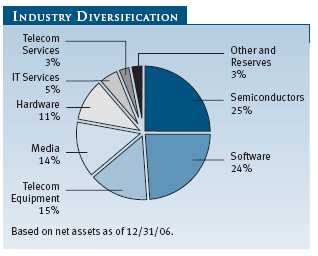
We believe that successfully investing in the technology sector involves correctly identifying product and technology adoption cycles and investing in the companies that provide the best products or are well positioned to take advantage of the growth opportunities related to the cycles. As we have highlighted in past letters, there are several major longer-term global technology cycles under way that we think offer interesting investment opportunities. Digital media is replacing analog in consumer devices, online advertising is quickly emerging from its infancy and becoming a major marketing medium, the outsourcing of business process and IT development to India is accelerating, the adoption of advanced communications technology in emerging markets is becoming commonplace, and broadband distribution is proliferating in the wireline and wireless universes. We have positioned the portfolio to take advantage of these longer-term secular growth trends and expect to address these themes in future letters.
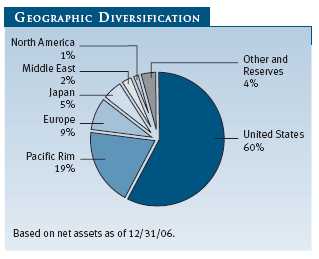
Many of our recent purchases have centered around these trends. For example, the fund’s largest purchase in 2006 was U.S. search engine Google. Google is front and center in two of the major trends we see in technology: the adoption of digital media and the move to online advertising. Apple, our third-largest purchase in the last six months, is well positioned to take advantage of the growth of digital media. Apple’s iPod is a revolutionary device that has accelerated the consumer’s adoption of digital audio and video. Finally, aQuantive, a U.S. digital marketing company, is a new addition. It provides services and technology that enable its customers to effectively design digital advertising campaigns and tools to analyze the returns on the effectiveness of their campaigns.
In 2007, we see the introduction of Microsoft’s Vista operating system and greater availability of the new video game platforms from Sony and Nintendo as having a beneficial ripple effect across the technology industry, and we have invested aggressively to take advantage of these product cycles. Microsoft remains the fund’s largest holding. We have recently added new stocks to the portfolio that provide components/software into the PC or gaming device supply chain including Taiwan-based Delta Electronics, a provider of power supplies to PCs and gaming platforms, Japan-based Ibiden, a provider of materials used to manufacture microprocessors, and U.S.-based Micron Technology, a leading manufacturer of memory semiconductors for PCs.
OUTLOOK
We believe that the healthy global economy will provide strong support for the new product cycles and secular technology trends currently under way. In addition, after years of price/earnings multiple compression and underperformance compared with the general market, technology stocks appear poised to benefit from better fundamentals and from valuations that are in line with the general market. We also anticipate a resolution of the options backdating issues that plagued technology stocks in 2006. Positive returns for our fund largely depend on a successful introduction of the Vista operating system, consumer adoption of digital media, and a continued migration of commerce and advertising to online channels. Although we are excited about the fundamental impact these cycles should have on technology demand, we are aware that technology stocks historically have underperformed in the first half of the calendar year. We are also cognizant that a large segment of investors in technology stocks have a shorter-term investment horizon than ours. Should economic data weaken in the near term, technology stocks are likely to be volatile.
As always, we appreciate your continued support.
Respectfully submitted,

Jeffrey Rottinghaus
President of the fund and chairman of its Investment Advisory Committee
January 17, 2007
RISKS OF INVESTING IN THE FUND
Funds that invest only in specific industries will experience greater volatility than funds investing in a broad range of industries. Technology stocks, historically, have experienced unusually wide price swings, both up and down. The potential for wide variation in performance reflects the special risks common to companies in the rapidly changing field of technology. For example, products or services that at first appear promising may not prove commercially successful and may become obsolete quickly. Earnings disappointments and intense competition for market share can result in sharp price declines.
GLOSSARY
Lipper Index: An index of mutual fund performance returns for specified periods in defined categories as tracked by Lipper Inc.
MSCI AC World Index–Information Technology: An index of technology companies operating in developed and emerging markets.
Price/earnings ratio: Calculated by dividing a stock’s market value per share by the company’s earnings per share for the past 12 months or by expected earnings for the coming year.
IMPORTANT INFORMATION ABOUT MORNINGSTAR RATINGS
For funds with at least a 3-year history, a Morningstar Rating™ is based on a risk-adjusted return measure (including the effects of sales charges, loads, and redemption fees) with emphasis on downward variations and consistent performance. The top 10% of funds in each category receive 5 stars, the next 22.5% 4 stars, the next 35% 3 stars, the next 22.5% 2 stars, and the bottom 10% 1 star. Each share class is counted as a fraction of one fund within this scale and rated separately. The fund received 4 and 5 stars for the 3- and 5-year periods, respectively.
© 2007 Morningstar, Inc. All Rights Reserved. The information contained herein: (1) is proprietary to Morningstar and/or its content providers; (2) may not be copied or distributed; and (3) is not warranted to be accurate, complete, or timely. Neither Morningstar nor its content providers are responsible for any damages or losses arising from any use of this information.
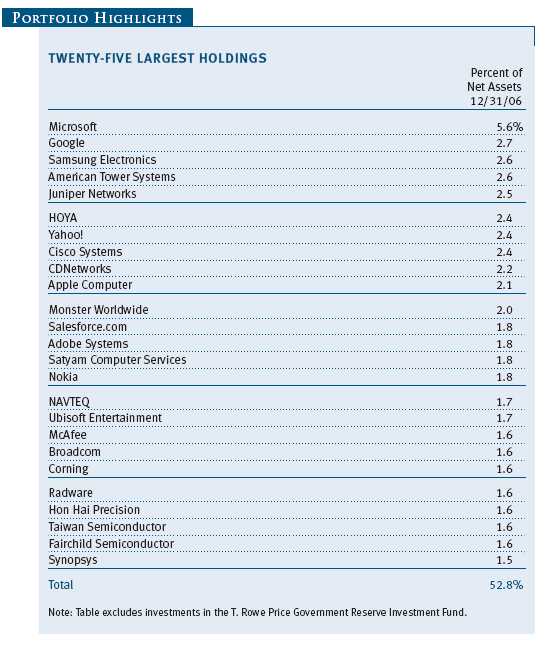
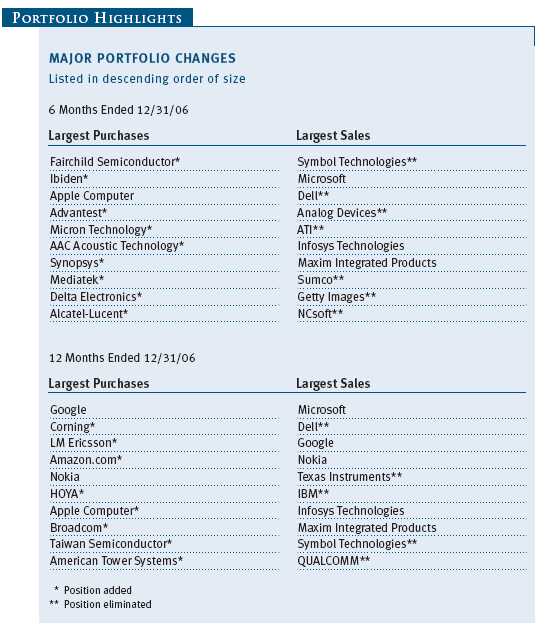
| GROWTH OF $10,000 |
This chart shows the value of a hypothetical $10,000 investment in the fund over the past 10 fiscal year periods or since inception (for funds lacking 10-year records). The result is compared with benchmarks, which may include a broad-based market index and a peer group average or index. Market indexes do not include expenses, which are deducted from fund returns as well as mutual fund averages and indexes.
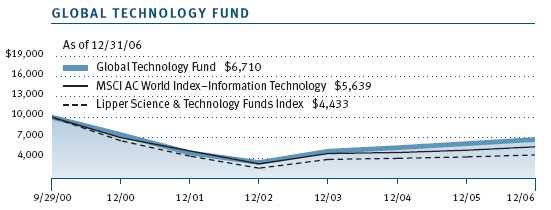
| AVERAGE ANNUAL COMPOUND TOTAL RETURN |
This table shows how the fund would have performed each year if its actual (or cumulative) returns for the periods shown had been earned at a constant rate.
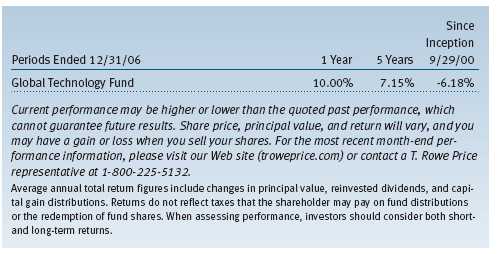
| FUND EXPENSE EXAMPLE |
As a mutual fund shareholder, you may incur two types of costs: (1) transaction costs, such as redemption fees or sales loads, and (2) ongoing costs, including management fees, distribution and service (12b-1) fees, and other fund expenses. The following example is intended to help you understand your ongoing costs (in dollars) of investing in the fund and to compare these costs with the ongoing costs of investing in other mutual funds. The example is based on an investment of $1,000 invested at the beginning of the most recent six-month period and held for the entire period.
Actual Expenses
The first line of the following table (“Actual”) provides information about actual account values and expenses based on the fund’s actual returns. You may use the information in this line, together with your account balance, to estimate the expenses that you paid over the period. Simply divide your account value by $1,000 (for example, an $8,600 account value divided by $1,000 = 8.6), then multiply the result by the number in the first line under the heading “Expenses Paid During Period” to estimate the expenses you paid on your account during this period.
Hypothetical Example for Comparison Purposes
The information on the second line of the table (“Hypothetical”) is based on hypothetical account values and expenses derived from the fund’s actual expense ratio and an assumed 5% per year rate of return before expenses (not the fund’s actual return). You may compare the ongoing costs of investing in the fund with other funds by contrasting this 5% hypothetical example and the 5% hypothetical examples that appear in the shareholder reports of the other funds. The hypothetical account values and expenses may not be used to estimate the actual ending account balance or expenses you paid for the period.
Note: T. Rowe Price charges an annual small-account maintenance fee of $10, generally for accounts with less than $2,000 ($500 for UGMA/UTMA). The fee is waived for any investor whose T. Rowe Price mutual fund accounts total $25,000 or more, accounts employing automatic investing, and IRAs and other retirement plan accounts that utilize a prototype plan sponsored by T. Rowe Price (although a separate custodial or administrative fee may apply to such accounts). This fee is not included in the accompanying table. If you are subject to the fee, keep it in mind when you are estimating the ongoing expenses of investing in the fund and when comparing the expenses of this fund with other funds.
You should also be aware that the expenses shown in the table highlight only your ongoing costs and do not reflect any transaction costs, such as redemption fees or sales loads. Therefore, the second line of the table is useful in comparing ongoing costs only and will not help you determine the relative total costs of owning different funds. To the extent a fund charges transaction costs, however, the total cost of owning that fund is higher.
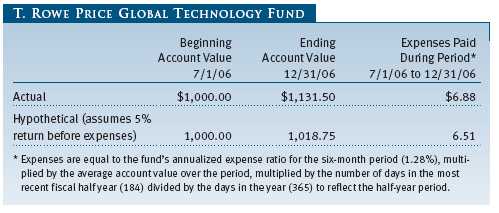
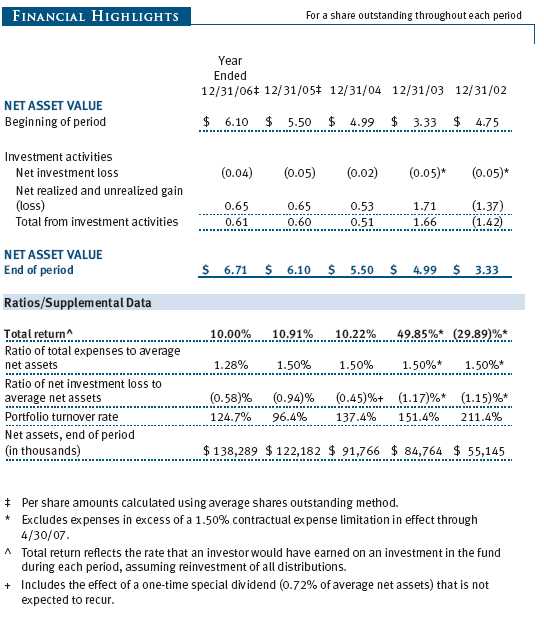
The accompanying notes are an integral part of these financial statements.
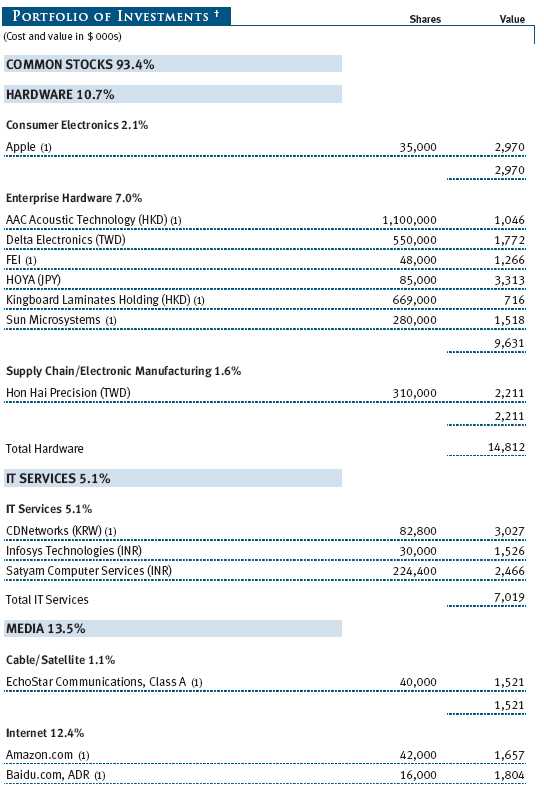
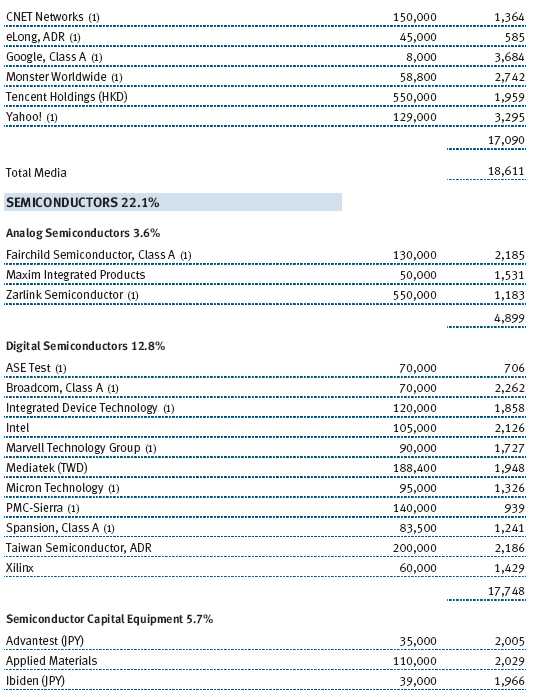
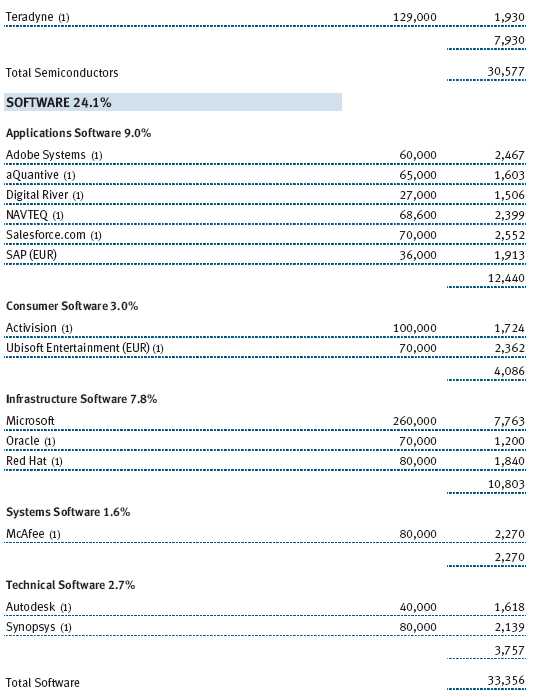
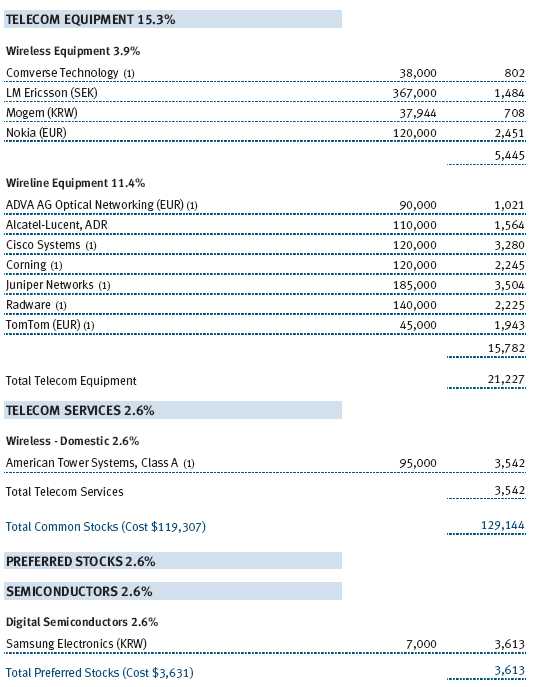
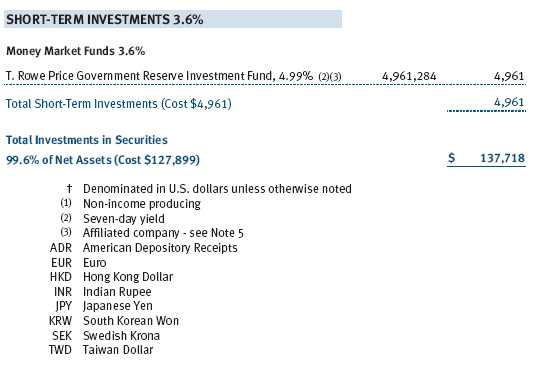
The accompanying notes are an integral part of these financial statements.
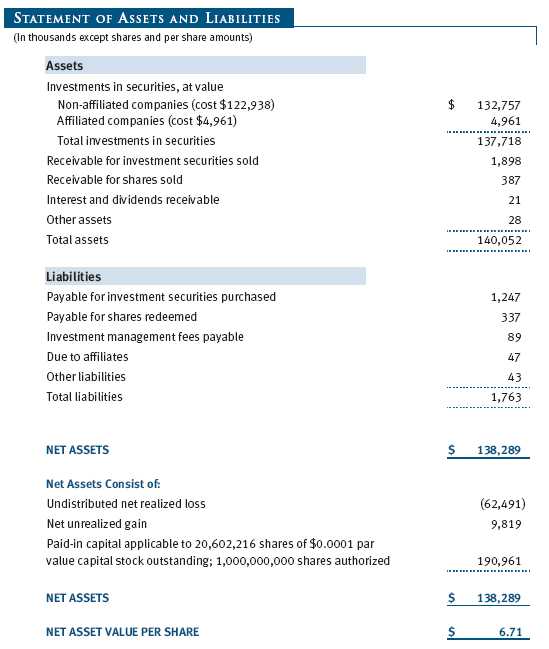
The accompanying notes are an integral part of these financial statements.
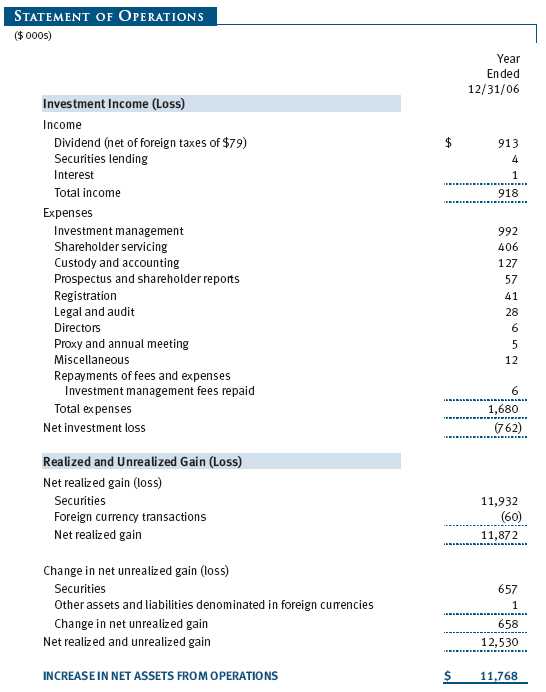
The accompanying notes are an integral part of these financial statements.
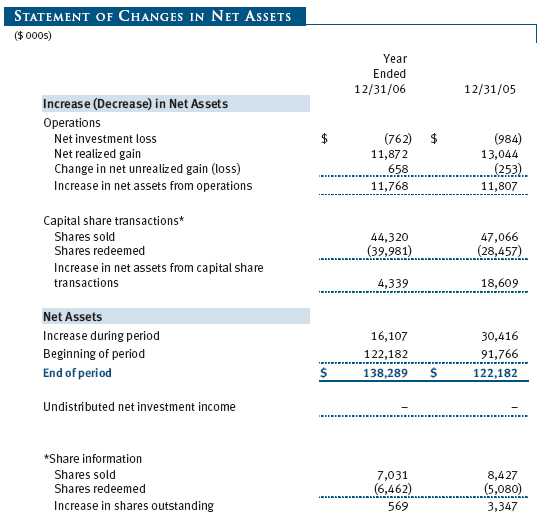
The accompanying notes are an integral part of these financial statements.
| NOTES TO FINANCIAL STATEMENTS |
NOTE 1 - SIGNIFICANT ACCOUNTING POLICIES
T. Rowe Price Global Technology Fund, Inc. (the fund), is registered under the Investment Company Act of 1940 (the 1940 Act) as a diversified, open-end management investment company. The fund commenced operations on September 29, 2000. The fund seeks to provide long-term capital growth.
The accompanying financial statements were prepared in accordance with accounting principles generally accepted in the United States of America, which require the use of estimates made by fund management. Fund management believes that estimates and security valuations are appropriate; however, actual results may differ from those estimates, and the security valuations reflected in the financial statements may differ from the value the fund ultimately realizes upon sale of the securities.
Valuation The fund values its investments and computes its net asset value per share at the close of the New York Stock Exchange (NYSE), normally 4 p.m. ET, each day that the NYSE is open for business. Equity securities listed or regularly traded on a securities exchange or in the over-the-counter (OTC) market are valued at the last quoted sale price or, for certain markets, the official closing price at the time the valuations are made, except for OTC Bulletin Board securities, which are valued at the mean of the latest bid and asked prices. A security that is listed or traded on more than one exchange is valued at the quotation on the exchange determined to be the primary market for such security. Listed securities not traded on a particular day are valued at the mean of the latest bid and asked prices for domestic securities and the last quoted sale price for international securities.
Investments in mutual funds are valued at the mutual fund’s closing net asset value per share on the day of valuation.
Other investments, including restricted securities, and those for which the above valuation procedures are inappropriate or are deemed not to reflect fair value are stated at fair value as determined in good faith by the T. Rowe Price Valuation Committee, established by the fund’s Board of Directors.
Most foreign markets close before the close of trading on the NYSE. If the fund determines that developments between the close of a foreign market and the close of the NYSE will, in its judgment, materially affect the value of some or all of its portfolio securities, which in turn will affect the fund’s share price, the fund will adjust the previous closing prices to reflect the fair value of the securities as of the close of the NYSE, as determined in good faith by the T. Rowe Price Valuation Committee, established by the fund’s Board of Directors. A fund may also fair value securities in other situations, such as when a particular foreign market is closed but the fund is open. In deciding whether to make fair value adjustments, the fund reviews a variety of factors, including developments in foreign markets, the performance of U.S. securities markets, and the performance of instruments trading in U.S. markets that represent foreign securities and baskets of foreign securities. The fund uses outside pricing services to provide it with closing market prices and information used for adjusting those prices. The fund cannot predict when and how often it will use closing prices and when it will adjust those prices to reflect fair value. As a means of evaluating its fair value process, the fund routinely compares closing market prices, the next day’s opening prices in the same markets, and adjusted prices.
Currency Translation Assets, including investments, and liabilities denominated in foreign currencies are translated into U.S. dollar values each day at the prevailing exchange rate, using the mean of the bid and asked prices of such currencies against U.S. dollars as quoted by a major bank. Purchases and sales of securities, income, and expenses are translated into U.S. dollars at the prevailing exchange rate on the date of the transaction. The effect of changes in foreign currency exchange rates on realized and unrealized security gains and losses is reflected as a component of security gains and losses.
Rebates and Credits Subject to best execution, the fund may direct certain security trades to brokers who have agreed to rebate a portion of the related brokerage commission to the fund in cash. Commission rebates are reflected as realized gain on securities in the accompanying financial statements and totaled $26,000 for the year ended December 31, 2006. Additionally, the fund earns credits on temporarily uninvested cash balances at the custodian that reduce the fund’s custody charges. Custody expense in the accompanying financial statements is presented before reduction for credits.
Investment Transactions, Investment Income, and Distributions Income and expenses are recorded on the accrual basis. Dividends received from mutual fund investments are reflected as dividend income; capital gain distributions are reflected as realized gain/loss. Dividend income and capital gain distributions are recorded on the ex-dividend date. Investment transactions are accounted for on the trade date. Realized gains and losses are reported on the identified cost basis. Distributions to shareholders are recorded on the ex-dividend date. Income distributions are declared and paid on an annual basis. Capital gain distributions, if any, are declared and paid by the fund, typically on an annual basis.
New Accounting Pronouncements In June 2006, the Financial Accounting Standards Board (“FASB”) issued FASB Interpretation No. 48 (“FIN 48”), Accounting for Uncertainty in Income Taxes, a clarification of FASB Statement No. 109, Accounting for Income Taxes. FIN 48 establishes financial reporting rules regarding recognition and measurement of tax positions taken or expected to be taken on a tax return. Management is evaluating the anticipated impact, if any, that FIN 48 will have on the fund upon adoption, which, pursuant to a delay granted by the U.S. Securities and Exchange Commission, is expected to be on the last business day of the fund’s semiannual period, June 29, 2007.
In September 2006, the FASB released the Statement of Financial Accounting Standard No. 157 (“FAS 157”), Fair Value Measurements. FAS 157 clarifies the definition of fair value and establishes the framework for measuring fair value, as well as proper disclosure of this methodology in the financial statements. It will be effective for the fund’s fiscal year beginning January 1, 2008. Management is evaluating the effects of FAS 157; however, it is not expected to have a material impact on the fund’s net assets or results of operations.
NOTE 2 - INVESTMENT TRANSACTIONS
Consistent with its investment objective, the fund engages in the following practices to manage exposure to certain risks or to enhance performance. The investment objective, policies, program, and risk factors of the fund are described more fully in the fund’s prospectus and Statement of Additional Information.
Emerging Markets At December 31, 2006, approximately 21% of the fund’s net assets were invested in securities of companies located in emerging markets or denominated in the currencies of emerging market countries. Future economic or political developments could adversely affect the liquidity or value, or both, of such securities.
Restricted Securities The fund may invest in securities that are subject to legal or contractual restrictions on resale. Although certain of these securities may be readily sold, for example, under Rule 144A, others may be illiquid, their sale may involve substantial delays and additional costs, and prompt sale at an acceptable price may be difficult.
Securities Lending The fund lends its securities to approved brokers to earn additional income. It receives as collateral cash and U.S. government securities valued at 102% to 105% of the value of the securities on loan. Cash collateral is invested in a money market pooled trust managed by the fund’s lending agent in accordance with investment guidelines approved by fund management. Collateral is maintained over the life of the loan in an amount not less than the value of loaned securities, as determined at the close of fund business each day; any additional collateral required due to changes in security values is delivered to the fund the next business day. Although risk is mitigated by the collateral, the fund could experience a delay in recovering its securities and a possible loss of income or value if the borrower fails to return the securities. Securities lending revenue recognized by the fund consists of earnings on invested collateral and borrowing fees, net of any rebates to the borrower and compensation to the lending agent. At December 31, 2006, there were no securities on loan.
Other Purchases and sales of portfolio securities, other than short-term securities, aggregated $161,289,000 and $160,209,000, respectively, for the year ended December 31, 2006.
NOTE 3 - FEDERAL INCOME TAXES
No provision for federal income taxes is required since the fund intends to continue to qualify as a regulated investment company under Subchapter M of the Internal Revenue Code and distribute to shareholders all of its taxable income and gains. Federal income tax regulations differ from generally accepted accounting principles; therefore, distributions determined in accordance with tax regulations may differ significantly in amount or character from net investment income and realized gains for financial reporting purposes. Financial reporting records are adjusted for permanent book/tax differences to reflect tax character. Financial records are not adjusted for temporary differences.
There were no distributions in the year ended December 31, 2006. At December 31, 2006, the tax-basis components of net assets were as follows:

Pursuant to federal income tax regulations applicable to investment companies, the fund has elected to treat net capital losses realized between November 1 and December 31 of each year as occurring on the first day of the following tax year. Consequently, $491,000 of realized losses reflected in the accompanying financial statements will not be recognized for tax purposes until 2007. The fund intends to retain realized gains to the extent of available capital loss carryforwards. During the year ended December 31, 2006, the fund utilized $12,419,000 of capital loss carryforwards. As of December 31, 2006, the fund had $62,000,000 of capital loss carryforwards, of which $28,418,000 expire in 2009 and $33,582,000 expire in 2010.
For the year ended December 31, 2006, the fund recorded the following permanent reclassifications to reflect tax character. Reclassifications to paid-in capital relate primarily to the current net operating loss. Results of operations and net assets were not affected by these reclassifications.

At December 31, 2006, the cost of investments for federal income tax purposes was $128,390,000.
NOTE 4 - FOREIGN TAXES
The fund is subject to foreign income taxes imposed by certain countries in which it invests. Additionally, capital gains realized by the fund upon disposition of securities issued in or by certain foreign countries are subject to capital gains tax imposed by those countries, which is payable prior to repatriation of sale proceeds. Similarly, a tax on net profits, including interest income and realized and unrealized capital gains, is imposed by certain other countries. All taxes are computed in accordance with the applicable foreign tax law, and, to the extent permitted, capital losses are used to offset capital gains. Tax expense attributable to income is accrued by the fund as a reduction of income. Current and deferred tax expense attributable to net capital gains is reflected as a component of realized and/or change in unrealized gain/loss on securities in the accompanying financial statements. At December 31, 2006, the fund had no taxes payable attributable to foreign securities, no deferred tax liability attributable to foreign securities, and $2,390,000 of foreign capital loss carryforwards, including $555,000 that expire in 2013, $894,000 that expire in 2014, and $941,000 that expire in 2015.
NOTE 5 - RELATED PARTY TRANSACTIONS
The fund is managed by T. Rowe Price Associates, Inc. (the manager or Price Associates), a wholly owned subsidiary of T. Rowe Price Group, Inc. The investment management agreement between the fund and the manager provides for an annual investment management fee, which is computed daily and paid monthly. The fee consists of an individual fund fee, equal to 0.45% of the fund’s average daily net assets, and a group fee. The group fee rate is calculated based on the combined net assets of certain mutual funds sponsored by Price Associates (the group) applied to a graduated fee schedule, with rates ranging from 0.48% for the first $1 billion of assets to 0.29% for assets in excess of $160 billion. The fund’s group fee is determined by applying the group fee rate to the fund’s average daily net assets. At December 31, 2006, the effective annual group fee rate was 0.31%.
The fund is also subject to a contractual expense limitation through April 30, 2007. During the limitation period, the manager is required to waive its management fee and reimburse the fund for any expenses, excluding interest, taxes, brokerage commissions, and extraordinary expenses, that would otherwise cause the fund’s ratio of total expenses to average net assets (expense ratio) to exceed its expense limitation of 1.50%. The fund is required to repay the manager for expenses previously reimbursed and management fees waived to the extent the fund’s net assets have grown or expenses have declined sufficiently to allow repayment without causing the fund’s expense ratio to exceed its expense limitation. However, no repayment will be made more than three years after the date of any reimbursement or waiver or later than April 30, 2009. Pursuant to this agreement, management fees in the amount of $6,000 were repaid during the year ended December 31, 2006. At December 31, 2006, the re were no amounts subject to repayment by the fund. For the year ended December 31, 2006, the fund operated below its expense limitation.
In addition, the fund has entered into service agreements with Price Associates and two wholly owned subsidiaries of Price Associates (collectively, Price). Price Associates computes the daily share price and provides certain other administrative services to the fund. T. Rowe Price Services, Inc., provides shareholder and administrative services in its capacity as the fund’s transfer and dividend disbursing agent. T. Rowe Price Retirement Plan Services, Inc., provides subaccounting and recordkeeping services for certain retirement accounts invested in the fund. For the year ended December 31, 2006, expenses incurred pursuant to these service agreements were $87,000 for Price Associates, $312,000 for T. Rowe Price Services, Inc., and $7,000 for T. Rowe Price Retirement Plan Services, Inc. The total amount payable at period-end pursuant to these service agreements is reflected as Due to Affiliates in the accompanying financial statements.
The fund may invest in the T. Rowe Price Reserve Investment Fund and the T. Rowe Price Government Reserve Investment Fund (collectively, the T. Rowe Price Reserve Funds), open-end management investment companies managed by Price Associates and affiliates of the fund. The T. Rowe Price Reserve Funds are offered as cash management options to mutual funds, trusts, and other accounts managed by Price Associates and/or its affiliates, and are not available for direct purchase by members of the public. The T. Rowe Price Reserve Funds pay no investment management fees. During the year ended December 31, 2006, dividend income from the T. Rowe Price Reserve Funds totaled $119,000, and the value of shares of the T. Rowe Price Reserve Funds held at December 31, 2006, and December 31, 2005, was $4,961,000 and $2,379,000, respectively.
As of December 31, 2006, T. Rowe Price Group, Inc. and/or its wholly owned subsidiaries owned 539,179 shares of the fund, representing 3% of the fund’s net assets.
| REPORT OF INDEPENDENT REGISTERED PUBLIC ACCOUNTING FIRM |
To the Board of Directors and Shareholders of T. Rowe Price Global Technology Fund, Inc.
In our opinion, the accompanying statement of assets and liabilities, including the portfolio of investments, and the related statements of operations and of changes in net assets and the financial highlights present fairly, in all material respects, the financial position of T. Rowe Price Global Technology Fund, Inc. (the “Fund”) at December 31, 2006, the results of its operations for the year then ended, the changes in its net assets for each of the two years in the period then ended and the financial highlights for each of the five years in the period then ended, in conformity with accounting principles generally accepted in the United States of America. These financial statements and financial highlights (hereafter referred to as “financial statements”) are the responsibility of the Fund’s management; our responsibility is to express an opinion on these financial statements based on our audits. We conducted our audits of these financial statements in accordance with the auditing standards of the Public Company Accounting Oversight Board (United States). Those standards require that we plan and perform the audit to obtain reasonable assurance about whether the financial statements are free of material misstatement. An audit includes examining, on a test basis, evidence supporting the amounts and disclosures in the financial statements, assessing the accounting principles used and significant estimates made by management, and evaluating the overall financial statement presentation. We believe that our audits, which included confirmation of securities at December 31, 2006 by correspondence with the custodian and by agreement to the underlying ownership records for T. Rowe Price Government Reserve Investment Fund, provide a reasonable basis for our opinion.
PricewaterhouseCoopers LLP
Baltimore, Maryland
February 12, 2007
| INFORMATION ON PROXY VOTING POLICIES, PROCEDURES, AND RECORDS |
A description of the policies and procedures used by T. Rowe Price funds and portfolios to determine how to vote proxies relating to portfolio securities is available in each fund’s Statement of Additional Information, which you may request by calling 1-800-225-5132 or by accessing the SEC’s Web site, www.sec.gov. The description of our proxy voting policies and procedures is also available on our Web site, www.troweprice.com. To access it, click on the words “Company Info” at the top of our homepage for individual investors. Then, in the window that appears, click on the “Proxy Voting Policy” navigation button in the top left corner.
Each fund’s most recent annual proxy voting record is available on our Web site and through the SEC’s Web site. To access it through our Web site, follow the directions above, then click on the words “Proxy Voting Record” at the bottom of the Proxy Voting Policy page.
| HOW TO OBTAIN QUARTERLY PORTFOLIO HOLDINGS |
The fund files a complete schedule of portfolio holdings with the Securities and Exchange Commission for the first and third quarters of each fiscal year on Form N-Q. The fund’s Form N-Q is available electronically on the SEC’s Web site (www.sec.gov); hard copies may be reviewed and copied at the SEC’s Public Reference Room, 450 Fifth St. N.W., Washington, DC 20549. For more information on the Public Reference Room, call 1-800-SEC-0330.
| ABOUT THE FUND’S DIRECTORS AND OFFICERS |
Your fund is governed by a Board of Directors that meets regularly to review a wide variety of matters affecting the fund, including performance, investment programs, compliance matters, advisory fees and expenses, service providers, and other business affairs. The Board of Directors elects the fund’s officers, who are listed in the final table. At least 75% of Board members are independent of T. Rowe Price Associates, Inc. (T. Rowe Price), and T. Rowe Price International, Inc. (T. Rowe Price International); “inside” or “interested” directors are officers of T. Rowe Price. The business address of each director and officer is 100 East Pratt Street, Baltimore, Maryland 21202. The Statement of Additional Information includes additional information about the fund directors and is available without charge by calling a T. Rowe Price representative at 1-800-225-5132.
| Independent Directors | |
| Name | |
| (Year of Birth) | Principal Occupation(s) During Past 5 Years |
| Year Elected* | and Directorships of Other Public Companies |
| Jeremiah E. Casey | Director, Allfirst Financial Inc. (previously First Maryland Bankcorp) |
| (1940) | (1983 to 2002); Director, National Life Insurance (2001 to 2005); |
| 2005 | Director, The Rouse Company, real estate developers (1990 to 2004) |
| Anthony W. Deering | Chairman, Exeter Capital, LLC, a private investment firm (2004 to |
| (1945) | present); Director, Vornado Real Estate Investment Trust (3/04 |
| 2001 | to present); Director, Mercantile Bankshares (4/03 to present); |
| Member, Advisory Board, Deutsche Bank North America (2004 | |
| to present); Director, Chairman of the Board, and Chief Executive | |
| Officer, The Rouse Company, real estate developers (1997 to 2004) | |
| Donald W. Dick, Jr. | Principal, EuroCapital Advisors, LLC, an acquisition and management |
| (1943) | advisory firm; Chairman, President, and Chief Executive Officer, |
| 2000 | The Haven Group, a custom manufacturer of modular homes |
| (1/04 to present) | |
| David K. Fagin | Chairman and President, Nye Corporation (6/88 to present); |
| (1938) | Director, Canyon Resources Corp., Golden Star Resources Ltd. |
| 2000 | (5/92 to present), and Pacific Rim Mining Corp. (2/02 to present) |
| Karen N. Horn | Director, Federal National Mortgage Association (9/06 to present); |
| (1943) | Managing Director and President, Global Private Client Services, |
| 2003 | Marsh Inc. (1999 to 2003); Director, Georgia Pacific (5/04 to 12/05), |
| Eli Lilly and Company, and Simon Property Group | |
| Theo C. Rodgers | President, A&R Development Corporation |
| (1941) | |
| 2005 | |
| John G. Schreiber | Owner/President, Centaur Capital Partners, Inc., a real estate |
| (1946) | investment company; Partner, Blackstone Real Estate Advisors, L.P. |
| 2001 | |
* Each independent director oversees 115 T. Rowe Price portfolios and serves until retirement, resignation, or election of a successor.
| Inside Directors | |
| Name | |
| (Year of Birth) | |
| Year Elected* | |
| [Number of T. Rowe Price | Principal Occupation(s) During Past 5 Years |
| Portfolios Overseen] | and Directorships of Other Public Companies |
| Edward C. Bernard | Director and Vice President, T. Rowe Price and T. Rowe Price Group, |
| (1956) | Inc.; Chairman of the Board, Director, and President, T. Rowe Price |
| 2006 | Investment Services, Inc.; Chairman of the Board and Director, |
| [115] | T. Rowe Price International, Inc., T. Rowe Price Retirement Plan |
| Services, Inc., T. Rowe Price Services, Inc., and T. Rowe Price Savings | |
| Bank; Director, T. Rowe Price Global Asset Management Limited and | |
| T. Rowe Price Global Investment Services Limited; Chief Executive | |
| Officer, Chairman of the Board, Director, and President, | |
| T. Rowe Price Trust Company; Chairman of the Board, all funds | |
| Brian C. Rogers, CFA, CIC | Chief Investment Officer, Director, and Vice President, T. Rowe Price |
| (1955) | and T. Rowe Price Group, Inc.; Vice President, T. Rowe Price Trust |
| 2006 | Company |
| [62] | |
* Each inside director serves until retirement, resignation, or election of a successor.
| Officers | |
| Name (Year of Birth) | |
| Title and Fund(s) Served | Principal Occupation(s) |
| Kennard W. Allen (1977) | Vice President, T. Rowe Price and T. Rowe Price |
| Vice President, Global Technology Fund | Group, Inc. |
| R. Scott Berg (1972) | Vice President, T. Rowe Price and T. Rowe |
| Vice President, Global Technology Fund | Price Group, Inc.; formerly student, Stanford |
| Graduate School of Business (to 2002) | |
| Joseph A. Carrier, CPA (1960) | Vice President, T. Rowe Price, T. Rowe Price |
| Treasurer, Global Technology Fund | Group, Inc., T. Rowe Price Investment Services, |
| Inc., and T. Rowe Price Trust Company | |
| David J. Eiswert, CFA (1972) | Vice President, T. Rowe Price and T. Rowe Price |
| Vice President, Global Technology Fund | Group, Inc.; formerly Analyst, Mellon Growth |
| Advisors and Fidelity Management and | |
| Research (to 2003) | |
| Roger L. Fiery III, CPA (1959) | Vice President, T. Rowe Price, T. Rowe Price |
| Vice President, Global Technology Fund | Group, Inc., T. Rowe Price International, Inc., |
| and T. Rowe Price Trust Company | |
| May Foo, CFA (1977) | Employee, T. Rowe Price |
| Vice President, Global Technology Fund | |
| Robert N. Gensler (1957) | Vice President, T. Rowe Price, T. Rowe Price |
| President, Global Technology Fund | Group, Inc., and T. Rowe Price International, Inc. |
| John R. Gilner (1961) | Chief Compliance Officer and Vice President, |
| Chief Compliance Officer, | T. Rowe Price; Vice President, T. Rowe Price |
| Global Technology Fund | Group, Inc., and T. Rowe Price Investment |
| Services, Inc. | |
| Gregory S. Golczewski (1966) | Vice President, T. Rowe Price and T. Rowe Price |
| Vice President, Global Technology Fund | Trust Company |
| Henry H. Hopkins (1942) | Director and Vice President, T. Rowe Price |
| Vice President, Global Technology Fund | Investment Services, Inc., T. Rowe Price |
| Services, Inc., and T. Rowe Price Trust | |
| Company; Vice President, T. Rowe Price, | |
| T. Rowe Price Group, Inc., T. Rowe Price | |
| International, Inc., and T. Rowe Price | |
| Retirement Plan Services, Inc. | |
| Patricia B. Lippert (1953) | Assistant Vice President, T. Rowe Price and |
| Secretary, Global Technology Fund | T. Rowe Price Investment Services, Inc. |
| Philip A. Nestico (1976) | Vice President, T. Rowe Price |
| Vice President, Global Technology Fund | |
| Hiroaki Owaki, CFA (1962) | Vice President, T. Rowe Price Group, Inc., and |
| Vice President, Global Technology Fund | T. Rowe Price Global Investment Services |
| Limited; formerly Senior Investment Analyst, | |
| ABN Amro Asset Management (to 2004) | |
| Jeffrey Rottinghaus, CPA (1970) | Vice President, T. Rowe Price and T. Rowe Price |
| Executive Vice President, | Group, Inc. |
| Global Technology Fund | |
| Michael F. Sola, CFA (1969) | Vice President, T. Rowe Price and T. Rowe Price |
| Vice President, Global Technology Fund | Group, Inc. |
| Joshua K. Spencer, CFA (1973) | Vice President, T. Rowe Price and T. Rowe Price |
| Vice President, Global Technology Fund | Group, Inc.; formerly Research Analyst and |
| Sector Fund Portfolio Manager, Fidelity | |
| Investments (to 2004) | |
| Chirag Vasavada (1972) | Vice President, T. Rowe Price; formerly Senior |
| Vice President, Global Technology Fund | Manager in the Corporate Strategy and |
| Development Group, Microsoft Corporation | |
| (to 2005) | |
| Julie L. Waples (1970) | Vice President, T. Rowe Price |
| Vice President, Global Technology Fund | |
| Wenhua Zhang, CFA, CPA (1970) | Vice President, T. Rowe Price and T. Rowe Price |
| Vice President, Global Technology Fund | Group, Inc. |
Unless otherwise noted, officers have been employees of T. Rowe Price or T. Rowe Price International for at least five years.
Item 2. Code of Ethics.
The registrant has adopted a code of ethics, as defined in Item 2 of Form N-CSR, applicable to its principal executive officer, principal financial officer, principal accounting officer or controller, or persons performing similar functions. A copy of this code of ethics is filed as an exhibit to this Form N-CSR. No substantive amendments were approved or waivers were granted to this code of ethics during the period covered by this report.
Item 3. Audit Committee Financial Expert.
The registrant’s Board of Directors/Trustees has determined that Mr. Donald W. Dick Jr. qualifies as an audit committee financial expert, as defined in Item 3 of Form N-CSR. Mr. Dick is considered independent for purposes of Item 3 of Form N-CSR.
Item 4. Principal Accountant Fees and Services.
(a) – (d) Aggregate fees billed to the registrant for the last two fiscal years for professional services rendered by the registrant’s principal accountant were as follows:

Audit fees include amounts related to the audit of the registrant’s annual financial statements and services normally provided by the accountant in connection with statutory and regulatory filings. Audit-related fees include amounts reasonably related to the performance of the audit of the registrant’s financial statements and specifically include the issuance of a report on internal controls and, if applicable for 2006, agreed-upon procedures related to fund acquisitions. Tax fees include amounts related to services for tax compliance, tax planning, and tax advice. The nature of these services specifically includes the review of distribution calculations and the preparation of Federal, state, and excise tax returns. Reclassification from tax fees to audit fees of fiscal 2005 amounts related to the auditing of tax disclosures within the registrant’s annual financial statements has been made in order to conform to fiscal 2006 presentation. All other fees include the registrant’s pro-rata share of amounts for agreed-upon procedures in conjunction with service contract approvals by the registrant’s Board of Directors/Trustees.
(e)(1) The registrant’s audit committee has adopted a policy whereby audit and non-audit services performed by the registrant’s principal accountant for the registrant, its investment adviser, and any entity controlling, controlled by, or under common control with the investment adviser that provides ongoing services to the registrant require pre-approval in advance at regularly scheduled audit committee meetings. If such a service is required between regularly scheduled audit committee meetings, pre-approval may be authorized by one audit committee member with ratification at the next scheduled audit committee meeting. Waiver of pre-approval for audit or non-audit services requiring fees of a de minimis amount is not permitted.
(2) No services included in (b) – (d) above were approved pursuant to paragraph (c)(7)(i)(C) of Rule 2-01 of Regulation S-X.
(f) Less than 50 percent of the hours expended on the principal accountant’s engagement to audit the registrant’s financial statements for the most recent fiscal year were attributed to work performed by persons other than the principal accountant’s full-time, permanent employees.
(g) The aggregate fees billed for the most recent fiscal year and the preceding fiscal year by the registrant’s principal accountant for non-audit services rendered to the registrant, its investment adviser, and any entity controlling, controlled by, or under common control with the investment adviser that provides ongoing services to the registrant were $1,401,000 and $883,000, respectively, and were less than the aggregate fees billed for those same periods by the registrant’s principal accountant for audit services rendered to the T. Rowe Price Funds. Preceding fiscal year amount reflects the reclassification of tax fees described in (a) – (d) above.
(h) All non-audit services rendered in (g) above were pre-approved by the registrant’s audit committee. Accordingly, these services were considered by the registrant’s audit committee in maintaining the principal accountant’s independence.Item 5. Audit Committee of Listed Registrants.
Not applicable.
Item 6. Schedule of Investments.
Not applicable. The complete schedule of investments is included in Item 1 of this Form N-CSR.
Item 7. Disclosure of Proxy Voting Policies and Procedures for Closed-End Management Investment Companies.
Not applicable.
Item 8. Portfolio Managers of Closed-End Management Investment Companies.
Not applicable.
Item 9. Purchases of Equity Securities by Closed-End Management Investment Company and Affiliated Purchasers.
Not applicable.
Item 10. Submission of Matters to a Vote of Security Holders.
Not applicable.
Item 11. Controls and Procedures.
(a) The registrant’s principal executive officer and principal financial officer have evaluated the registrant’s disclosure controls and procedures within 90 days of this filing and have concluded that the registrant’s disclosure controls and procedures were effective, as of that date, in ensuring that information required to be disclosed by the registrant in this Form N-CSR was recorded, processed, summarized, and reported timely.
(b) The registrant’s principal executive officer and principal financial officer are aware of no change in the registrant’s internal control over financial reporting that occurred during the registrant’s second fiscal quarter covered by this report that has materially affected, or is reasonably likely to materially affect, the registrant’s internal control over financial reporting.
Item 12. Exhibits.
(a)(1) The registrant’s code of ethics pursuant to Item 2 of Form N-CSR is attached.
(2) Separate certifications by the registrant's principal executive officer and principal financial officer, pursuant to Section 302 of the Sarbanes-Oxley Act of 2002 and required by Rule 30a-2(a) under the Investment Company Act of 1940, are attached.
(3) Written solicitation to repurchase securities issued by closed-end companies: not applicable.
(b) A certification by the registrant's principal executive officer and principal financial officer, pursuant to Section 906 of the Sarbanes-Oxley Act of 2002 and required by Rule 30a-2(b) under the Investment Company Act of 1940, is attached.
SIGNATURES | |
| Pursuant to the requirements of the Securities Exchange Act of 1934 and the Investment | |
| Company Act of 1940, the registrant has duly caused this report to be signed on its behalf by the | |
| undersigned, thereunto duly authorized. | |
| T. Rowe Price Global Technology Fund, Inc. | |
| By | /s/ Edward C. Bernard |
| Edward C. Bernard | |
| Principal Executive Officer | |
| Date | February 16, 2007 |
| Pursuant to the requirements of the Securities Exchange Act of 1934 and the Investment | |
| Company Act of 1940, this report has been signed below by the following persons on behalf of | |
| the registrant and in the capacities and on the dates indicated. | |
| By | /s/ Edward C. Bernard |
| Edward C. Bernard | |
| Principal Executive Officer | |
| Date | February 16, 2007 |
| By | /s/ Joseph A. Carrier |
| Joseph A. Carrier | |
| Principal Financial Officer | |
| Date | February 16, 2007 |